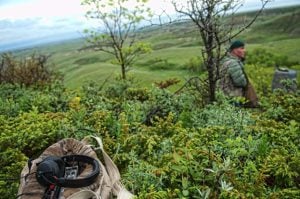
Science & Tech
The sounds of silence
A sound artist listens for quiet in Grasslands National Park
- 5035 words
- 21 minutes
Mapping

A recent article from the journal Science talks about what scientists are calling the “anthropause” — where, when human activity came to a screeching halt this spring, noise attributed to human activity dropped more than 50 per cent. One of the authors, University of British Columbia professor and geophysicist Mika McKinnon, spoke with Canadian Geographic about the study, disaster planning and her own personal “anthropause.”
On putting the study together
It was an accident — there are seismic trackers in places all over the world and there are people who watch the data and report on what they see, and it came from that. The Global Seismographic Network is a collection of seismic monitors, which have 360 degree mics to detect vibrations. A global network of geophysics pool their data, as part of the Nuclear Test-Ban Treaty, and we can look at that to see trends or new patterns. As a geophysicist, a lot of the job is that you have all this data, but you need to work backwards and use context to figure out how to interpret it, so that’s what we did. The tech already existed and we did the work based on figuring out what we were seeing there.
On COVID’s impacts on her work
Geophysics equipement is fragile and is brought outdoors to be turned on, but it usually means a lot of maintenance.That’s usually done during the summer, but right now people can’t travel to the equipment. [Our people] are all now working from home, teaching, managing kids and their students, they have the same stresses as everyone else — it’s not fun and definitely not easy.
On planning for disaster
I work in disasters and disaster communication, and a lot of people don’t think about disaster plans until they need them — it gets shuffled down in the grand scheme. With COVID-19, there are a lot of changes people made that doubled up as forms of disaster preparedness — people are more willing to think about these things right now and it results in larger personal preparedness for other disasters. Being prepared for these things makes me feel like I’m living in a blanket fort, and I want everyone else to be able to come into it and feel safe as well.
On what’s next for her research
We’re doing a follow up chunk of research on what we see specifically as reopening happens — Canada’s a unique situation when it comes to the population density. There are now more seismic stations in cities, made of converted Raspberry Pis, which are good for traffic density and rush hour. During COVID-19, they’ve been able to track how much physical activity is going on, and to be able to be the start of us understanding what’s impacting those levels in terms of health policy and things like urban/rural divides, or industry specific cities.
Are you passionate about Canadian geography?
You can support Canadian Geographic in 3 ways:

Science & Tech
A sound artist listens for quiet in Grasslands National Park

Environment
As the impacts of global warming become increasingly evident, the connections to biodiversity loss are hard to ignore. Can this fall’s two key international climate conferences point us to a nature-positive future?

Environment
The planet is in the midst of drastic biodiversity loss that some experts think may be the next great species die-off. How did we get here and what can be done about it?

History
On April 1, 1999, Canada’s youngest population took control of its largest territory. Here’s how Canadian Geographic covered the story.